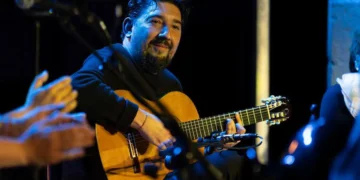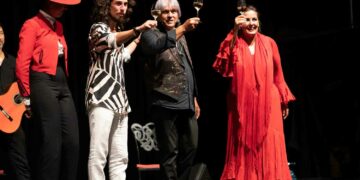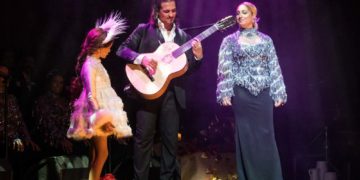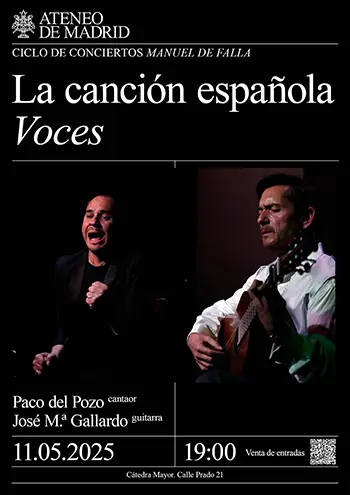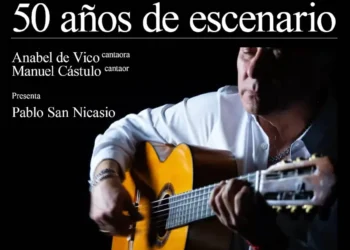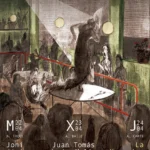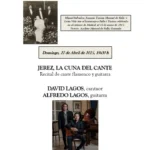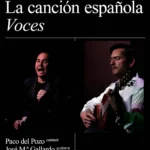|
ANTONIO REY & |
||||||
|
Text: Pablo San Nicasio “Two Antonios full speed ahead” Once again this year flamenco figures prominently on the program of Madrid’s “Los Veranos de la Villa”. Shows are announced for the Pradillo and Lara theaters, as well as the Puerta del Ángel and Sabatini gardens. The latter venue has long been a standby for summer programs. This year the cutbacks in the program have been substantial, not so much in the number of shows, but in the weight of the performers. A quick look at past programs, and you get the idea. And Sabatini is the most obvious proof. A prestigious stage of singular beauty, this year’s scaled-down edition has the attraction of featuring individuals who, in better financial times, probably wouldn’t be on the program. So anyone who thinks the same things are always programmed, should pass by the Palacio Real to see what’s afoot. All’s well that ends well, and it’s always a positive thing when festivals are open to lesser-known artists. A double show was announced for Wednesday. First up was Antonio Rey, a guitarist from the new wave, influenced by the generations that have inspired everyone else, making it so difficult to say something new in flamenco concert guitar which easily sounds hackneyed. The Madrid guitarist who lives in Jerez, offered a brief recital of a half hour in which he interpreted some pieces from his first and only recording, “A Través de Ti”. And the title piece of the recording, the rumba he used to close, was the most original part of a recital in which his great admiration for Paco de Lucía came through, and even moreso, for Vicente Amigo. Technically clean and impressive, which is half the battle, his music nevertheless was singularly lacking in originality. The opening taranta was an exact copy of the Amigo model except for some inspired pizzicato. The alegrías was all pyrotechnics continually reminiscent of La Barrosa. Bolero, rumba and bulerías suffered from the same problem. Unsurpassable technique, no question about it, but too much copying of Paco and Vicente. Towards the end, and opening the door to new ideas was the afore-mentioned “A Través de Ti”. That was where we could see that at some future time this might be a guitarist who will break molds. It’s possible Antonio had little time to select the most authentic repertoire, and went for the crowd-pleasers. Antonio Rey’s same group (Popo on bass, the violin of Bernardo Parrilla, the cante de Pedro “el Granaíno” and the percussion de Isidro Suárez), took on the job of accompaniment in the second part. This was where the group seemed to be more at home. Antonio and his people comprise the great back-up for the Farrucos, and in that sense it’s where they are best appreciated. It was here Antonio Rey played more original music, more in tone with the occasion, without thinking of the competition, just him and his dancer. The second part of the show was devoted to Antonio Fernández Montoya “Farru”, with all the media aura associated. It’s possible that “Al Son de Farruco” is what one expects would have attracted the masses on Wednesday night. And it was perhaps half true. Lots of empty seats nonetheless, but a good overall atmosphere with unbridled cheers of encouragement from the gypsy contingent. In addition to the musicians who had opened the night, Farru incorporated another guitarist (his solo was the best part of the night), and two other singers, all regular members of gypsy groups such as those of Tomatito, Cigala, Jesús del Rosario, etc. The visceral instinctive dancer from Sevilla (he’s not one of these ones who spends hours in the rehearsal studio, his dancing just comes out spontaneously) grew in intensity right up the closing soleá. More than twenty minutes in which Antonio developed only the accelerated bulerías portions where nothing was held back. Bulerías and tangos were the exclusive turf of Farru. This subtracts from the variety of the show and is becoming established as the obligatory repertoire of gypsy artists. Although there were also fandangos and a laidback soleá, but only as filler, to make time for the star to make it to the dressing-room to change costume. Impressive feet, with the main attraction being the dancer’s innate ability to adapt to the compás, his charisma and his star presence. He’s a natural. It would be interesting to see him in a show with a plot, telling a story via choreography, but that might not be a viable option for this type of performer. The entire group was outstanding, especially the guitarists and Bernardo Parrilla on violin, the only gypsy flamenco violinist. It was already the wee hours, but half the chairs were still full waiting for the real fiesta. |










